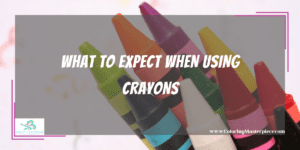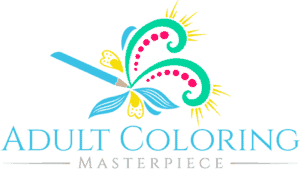We’ve all been there. The moment you start to color something in is the same moment you start to question your art. The coloring stage is intimidating, especially when you’re using an unforgiving medium like crayons. But there’s hope.
To color with crayons better you need to understand just how they work, be prepared for their most common mistakes, and practice basic application techniques.
Crayons are tricky because you think you know them, but often what you know is either wrong or extremely basic. When you move on from scribbling in school to professional coloring there’s often more to learn than you could ever imagine.
What to Expect When Using Crayons

You don’t want to waste time working with a medium that won’t work for you, so let’s discuss what exactly you can expect crayons to do. Once you come to terms with both their benefits and their limits you can better decide whether they’re the right fit for your project.
Crayons work great for:
- Coloring Smoothly: They are extremely soft, so color applies more evenly than it would with a colored pencil.
- Consistent Color: Crayons are more simply constructed, so the pigment has less variation than in other mediums that use binders. This means you’re at less of a disadvantage when placing color.
- Versatility: You can use the whole crayon in a variety of ways. This opens the doors to unique textures and mixed-media art.
Crayons don’t work so well for:
- Finer Detailing: Because a crayon is softer it is harder to maintain a fine point. You can keep sharpening your crayon, but that is time-consuming.
- Layering: Crayons are pigmented wax, so they develop wax bloom quite easily. This can make it difficult to blend and layer, so your work is more likely to lack depth in those areas.
- Making Mistakes: If you’re the type of person who runs by the seat of your pants, you may not want to use crayons. They aren’t a forgiving medium, so once you mark them on the page you’ll be stuck with that. While this is a great opportunity for adaptable artists, it can be stressful.
This isn’t a checklist for usability, but it’s a great starting point. It would be unfortunate to get halfway through a project and realize that crayons aren’t going to cut it. Once you’ve decided, you move on to their application.
Basic Crayon Techniques
The first thing I will tell you is this: use a brand that you’re comfortable with. A lot of people will say it isn’t real art if you’re using school crayons, but I just don’t agree with that. If you find professional brands intimidating there is little reason to abandon the box of Crayolas that you’re already familiar with. Art is what comes from your mind, body, and soul, and it has no care for the brand of the materials you use.
That being said, don’t treat crayons like you’re coloring in school. Apply them deliberately and carefully, and plan out every stage of your journey. Coloring with crayons is a bit like playing chess in that you need to see every outcome a few steps ahead.
Build your colors gradually, starting with the lightest. Don’t count on being able to add too many layers. If you’re unsure, attempt the blend on a scratch sheet of paper. While crayons are difficult to erase, you can still scratch the wax off to etch out small lines and details. This unique technique gives crayons an advantage over other mediums, so use it where you can.
And, as always, take your time with your work. You probably won’t be happy with your first piece, and that’s okay. Crayons have great potential, but they have some niche traits. Even if you’re coming from using colored pencils you’re bound to run into problems you didn’t anticipate. Don’t be so hard on yourself that you give up entirely. Everyone has room for improvement, and if you’re here trying to get better you’re moving in the right direction.
Common Crayon Mistakes (And How to Fix Them)

Even with these basic methods, you’re bound to run into issues. No one is perfect, and luck is rarely on anyone’s side. To color better, you will want to be overly prepared for the complications you may face.
Here are the most common problems that arise:
- You can’t apply more than one layer. While crayons aren’t great for layering, you should still be able to slap a few on. Make sure you’re using heavier, toothier paper that gives room for the color to apply. If this isn’t the problem then try using a lighter hand when coloring.
- Details are impossible. Again, crayons aren’t my go-to for detailed work, but you’re bound to need to add details at some point. Make sure you’re keeping the tip of your crayons sharp for this. Toothier paper helps out here too.
- The coloring looks childish. It takes a lot to cross the bridge from using crayons for basic coloring and using crayons for quality art. The odds are you’re rushing your work and skipping opportunities to blend and detail. Take your time. The practice blends on scratch paper, and pay close attention to your reference piece.
- You can see which direction I colored in. If you color by repeating lines that will be evident in your finished piece. To avoid this, color using smaller circular or oval shapes that overlap. I’ll go over blending methods in the next section, but using round strokes will improve your blend.
- The image looks completely off when I’m done. I’m sorry to say it, but you probably started with a poor drawing. Crayons aren’t great for fixing mistakes made in the drawing phase, so you need to make sure the initial drawing is as perfect as you can get it before coloring it in.
Hopefully, after reading this you’re able to avoid these issues. The one thing you can’t avoid, however, is the need to blend your work.
Learn more crayon tips HERE.
Blending
Yes; I am giving blending an entire section to itself. Blending crayons is not easy in the slightest, but mastering them can significantly level up your work. Before we get into blending methods let’s make sure you’re setting yourself up for success. To blend you’re going to need white space. This means you want heavier, toothier paper. If you use something basic like computer paper you aren’t giving your workroom to blend. Start with your light colors, and don’t apply them too heavily. It’s better to finish adding all the colors and realize you have room for more than it is to run out of layers.
Practice these methods so you can have a variety of blending approaches to choose from.
- White Crayon: When you’re done adding all the color you can use a white (or even light) crayon to push the tooth of the paper down and blend the pigments. Be careful; if you push down too hard you can tint the original color and lose some vibrancy.
- Oil: Coat—don’t drench—a Q-tip with oil (baby oil works great) and use that to push the color into the paper and smooth things out. Make sure you have plenty of Q-tips to use so you don’t muddle your color. This may leave a film, but it usually goes away.
- Paper: In a pinch, you can use tissues or even dry cotton balls or swabs to push the crayon around on the paper. This works best if you already have a decent amount on the surface, and it lifts the pigment, so this isn’t my first suggestion.
- Heat: This is a method of blending intrinsic to crayons. Because they react so strongly to heat you can use them to create a softer application that is much easier to blend. If you heat the paper before coloring you will be rewarded with a richer color that moves effortlessly.
These are, by no means, the only methods of blending you can use, but their mastery will boost your coloring game. You will probably also find that certain tactics work better in certain situations.
Frequently Asked Questions
Which crayons are the best?
The best crayon is the one in your hand, but that probably isn’t the answer you’re looking for. If you’re on a budget, Crayola crayons work fantastic. If you’re able to spare a few more coins I suggest Caran d’Ache Neocolors, either I or II.
Which medium is most similar to crayons?
If you’re asking in terms of structure, pastels are the most similar. However, wax-based colored pencils will apply and behave most similarly to crayons.
Is it better to use more colors or fewer colors with crayons?
Because crayons are more resistant to blending I lean towards using more colors. If you had to choose between using yellow-orange or both yellow and orange crayons you would have more blending opportunities using the premixed color. Crayons also come in more color varieties than most mediums, and that’s something you might want to take advantage of.
Maximize the benefits of coloring with my free adult coloring eBook and by signing up for my email newsletter HERE!
Disclaimer: The information provided by ColoringMasterpiece.com (“The Site”) is for general informational purposes only. All information on the Site is provided in good faith, however, we make no representation or warranty of any kind, express or implied, regarding the accuracy, adequacy, validity, reliability, availability, or completeness of any information on the Site. Under no circumstance shall we have any liability to you for any loss or damage of any kind incurred as a result of the use of the Site or Reliance on any information provided on the Site. Your use of the Site and your reliance on any information on the Site is solely at your own risk. This blog post is for educational purposes only and does not constitute legal advice. Please consult a legal expert to address your specific needs.
Terms and Conditions: https://coloringmasterpiece.com/terms-and-conditions/
